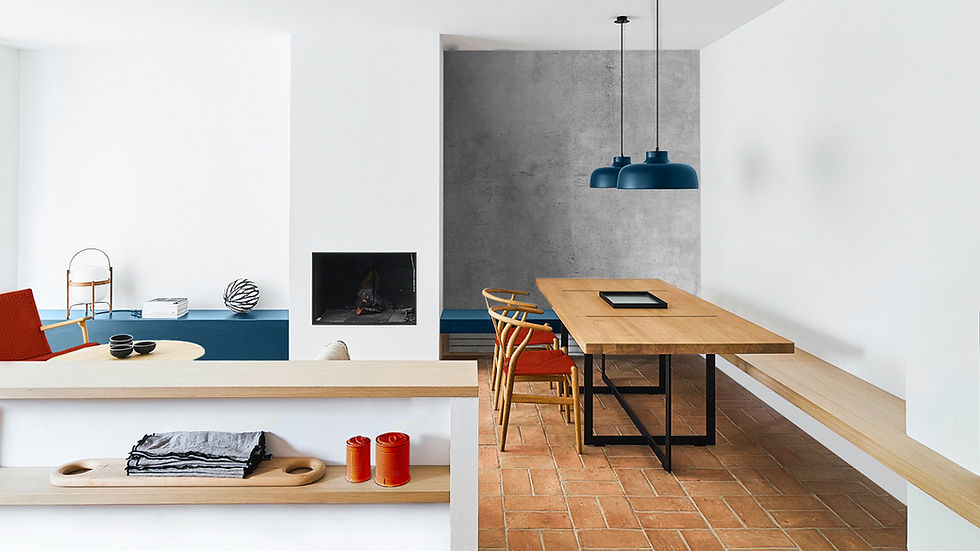The Power of Color: Using Psychology in Interior Design
- Design touch24

- Jun 16, 2023
- 3 min read

Introduction:
Color has a profound impact on our emotions, mood, and overall well-being. When it comes to interior design, understanding the psychology of color can help create spaces that evoke desired feelings and set the tone for different activities. In this article, we will explore the power of color and how it can be effectively utilized in interior design to create harmonious, inspiring, and functional spaces. From soothing blues to energizing yellows, let's delve into the fascinating world of color psychology and discover how it can transform your home.
Calming Blues: Shades of blue, such as soft sky blues or tranquil ocean hues, evoke a sense of calmness and serenity. These colors are ideal for bedrooms, bathrooms, or spaces where relaxation and tranquility are desired. Incorporate blue through wall paint, bedding, or accessories to create a soothing atmosphere.
Energizing Yellows: Yellow is a vibrant and energizing color associated with positivity and happiness. It stimulates creativity and optimism, making it a great choice for home offices, kitchens, or spaces where productivity and lively interactions take place. Introduce yellow through accent walls, furnishings, or decorative elements to infuse energy into your environment.
Invigorating Reds: Red is a bold and passionate color that elicits strong emotions. It is known to increase energy levels and stimulate conversation. Use red as an accent color in social spaces like dining areas or living rooms to create a lively and inviting atmosphere. Be mindful of its intensity and balance it with neutral tones to avoid overwhelming the space.
Serene Greens: Green is often associated with nature and has a calming and refreshing effect on the mind. It represents growth, harmony, and balance. Incorporate green in areas where relaxation and rejuvenation are desired, such as bedrooms, reading nooks, or meditation spaces. Use green through wall paint, plants, or natural textures to create a serene oasis.
Grounding Neutrals: Neutrals like whites, grays, and earth tones provide a versatile and timeless backdrop in interior design. They create a sense of balance, allowing other colors and elements to take center stage. Neutrals are perfect for creating a calm and sophisticated atmosphere in any room. Experiment with different shades and textures to add depth and warmth.
Playful Oranges: Orange is a warm and energetic color that combines the vibrancy of red with the brightness of yellow. It brings warmth and enthusiasm to a space and is often associated with creativity and fun. Incorporate orange in playrooms, creative studios, or areas where social interaction and positive energy are encouraged.
Tranquil Purples: Purple is a color that represents luxury, spirituality, and tranquility. Lighter shades of purple, such as lavender or lilac, can create a serene and dreamy ambiance in bedrooms or relaxation spaces. Deeper shades like royal purple or eggplant can add a touch of opulence and sophistication to living areas or dining rooms.
Sophisticated Blacks: While black is often associated with darkness, when used strategically, it can add sophistication and elegance to a space. Black accents or furniture pieces can create a striking contrast and focal point in a room. When balanced with lighter colors, black can bring depth and a sense of drama to any interior.
Harmonious Color Combinations: Understanding color combinations and their impact is crucial in interior design. Complementary colors, such as blue and orange or yellow and purple, create a vibrant and visually pleasing contrast. Analogous color schemes, where adjacent colors on the color wheel are used, create a harmonious and cohesive look. Experiment with different combinations to achieve the desired atmosphere.
Personal Preference and Balance: While color psychology provides valuable insights, personal preference should always be considered. Ultimately, the goal is to create a space that resonates with your individual tastes and needs. Strike a balance between incorporating colors that evoke the desired emotions and creating a space that reflects your personality and style.
Conclusion:
Color is a powerful tool in interior design, capable of influencing our emotions and enhancing our living spaces. By understanding the psychology of color and its impact, you can create environments that promote relaxation, productivity, creativity, or social interaction. Experiment with different colors, combinations, and intensities to transform your home into a harmonious and inspiring haven that truly reflects your unique personality and desires.




Comments